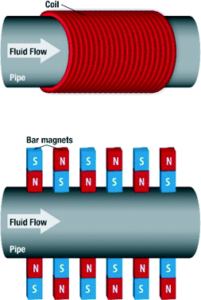Magnetic treatment
The world today suffers from the limited amounts of available water, and the increase in population, especially industries that use water frequently, such as poultry farms, livestock farms, hotels….etc.
The starting of magnetic treatment technology:
Whereas, the consequences of the lack of potable water were so severe that harmful chemicals were sought to remedy the situation. These chemicals, though effective, do more harm than good because they render water unsuitable for human consumption and cause ecological imbalance.
This led to the search for new methods and technologies for water treatment, including magnetic treatment of water, which is a relatively new technology in water crisis management. Where exposure to magnetic field changes the physical and chemical properties of water molecules resulting in unique properties, magnetized water has shown different properties with potential applications in different fields of environmental management. Among these applications are soil enhancement, plant growth, crop yield improvement, water-saving, and wastewater treatment.
Magnetic water treatment restructures water molecules into tiny molecules, facilitating their movement through pathways in plant and animal cell membranes. In addition, toxic agents cannot enter the magnetically treated water structure.
These features make water magnetic treatment a friendly compound for plant and animal cells, thus magnetic water treatment has become the ideal solution.
The general idea of magnetic treatment devices work:
Magnetic treatment devices used in water treatment generally consist of either a permanent magnet or an electromagnet.

The field strength varies with the number of turns of the electric wire or the thickness of the wire used to generate the electromagnets. When using permanent magnets, the arrangement is also different. Some are arranged with alternating poles of magnets, while some are arranged without rotation. The sole objective of either configuration is to produce a magnetic field within the channel as the fluid passes through. The generated magnetic field can also be stationary, pulsating, perpendicular to the fluid flow, or generated in the direction of fluid flow. When considering studies conducted by researchers in relation to magnetic water treatment, reference is made to the type of device, type of field, and strength, as well as other relevant details, if applicable.
Recent decades have seen an increase in the applications of magnetic treatments in various fields including:
- Therapeutic, diagnostic, and environmental medicine.
- Departments and industrial procedures.
- Magnetic water treatment is one of these applications with promising potential in the field of health, industry, and the environment. Water is a critical resource for life and any living organism needs it to hydrate every cell. Prolonged and frequent droughts and competing water demand in most parts of the world have caused severe pressures on water resources. In addition, the high cost of irrigation worldwide is the main problem of agricultural development, so the development of new technologies for water consumption has attracted the interest of scientists around the world. the world.
- Sewage water treatment.
Basic principles of magnetic water treatment technology:
Magnetic treatment of water is a simple and effective approach in which water flows through a magnetic field or group of magnetic fields which thus acquires different physical and chemical properties. Water is a small, positive magnetic compound, and has a high susceptibility to the magnetic field. Water molecules, like others, are slightly attracted by the magnetic field while not retaining magnetic properties when the external field is removed.
water magnetic treatment redirects water molecules into very small clusters, which are small and uniform mass having a hexagonal structure and thus can easily enter passageways in plant and animal cell membranes. In addition, toxic agents cannot enter the magnetically treated water structure. These features make magnetically treated water an environmentally friendly compound, for plants and animals.
Magnetic treatment of water can also be used to increase crop yields, stimulate seed germination and benefit livestock health.
Studies have proven that magnetic treatment of irrigation water can improve water productivity; Thus, maintaining the expected future water supply.
In addition, magnetic treatment of water has been shown to be effective in preventing and removing limescale in water-containing pipes and structures.
Magnetic treatment of water boosts carbon dioxide and H+ levels in the soil similar to adding fertilizer.
The German Magnolith device is one of the best water magnetic treatment devices to learn more about this device and its many advantages


























